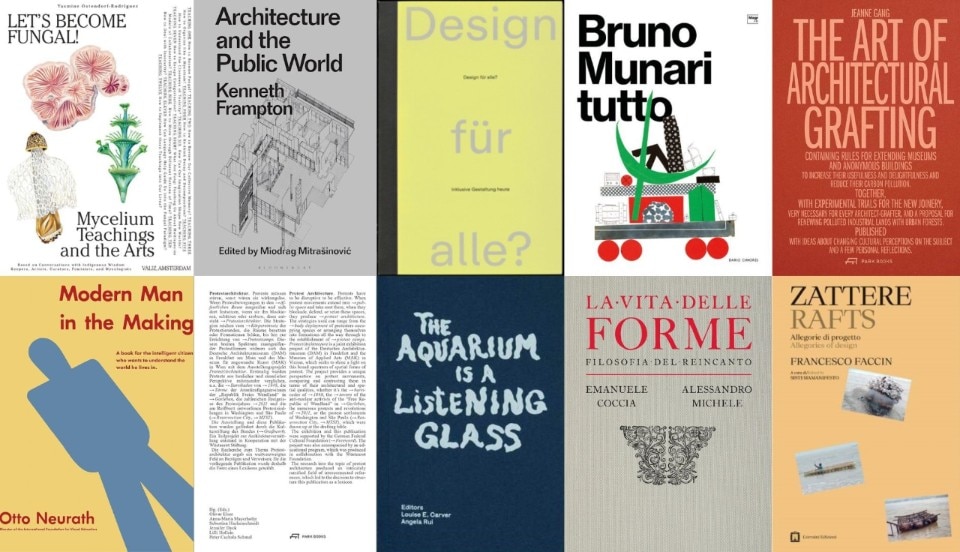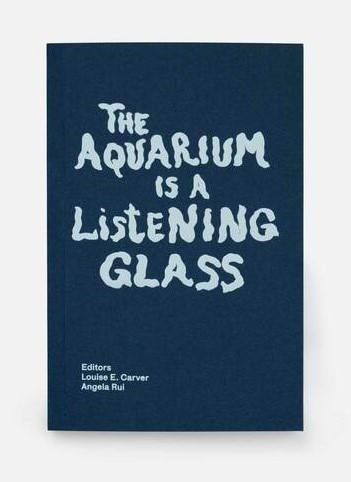We live in turbulent times - times of social change, cultural and ethical crises, and climate turmoil. In this setting, not only summer becomes a time for much-needed fleeting recreation and invigorating rest but also a moment for reflection. One of the most significant challenges society faces today is its expansion. Civil rights, inclusion, and integration are concepts and principles that ignite debates and generate hopes and fears, identity retreats, and community utopias.
10 books for this summer
Aquariums, mushrooms, artificial intelligence, barricades: these are some of the themes of the books we have selected for this summer, to reflect a world in which design is radically rethinking its role.

View Article details
- Emanuele Quinz
- 16 July 2024
Design is at the forefront of reconfiguring our social landscape. Historically, it has been seen as a tool of human dominance over nature. Today, however, design must be rethought as a means of rebalancing inequalities, not only among humans but also between different species. The world is growing bigger and bigger and new buzzwords are emerging: interdependence, coexistence, grafting, accessibility, adaptation, but also re-enchantment. Renewing moral imperatives and addressing deviations is not enough; we must also rediscover the meaning of things hidden in the intricate web of connections between various forms of life: the beauty of living and living together.
In this spirit, we present a list of 10 suggested readings for the summer of 2024. These books aim to invigorate the spirit, stimulate reflection, and renew what Tomas Maldonado called “the design hope.”
1. The Aquarium is a Listening Glass

A small but extensive-like-an-ocean booklet. This book, following the “Aquaria” exhibition presented at MAAT in Lisbon in 2021, is the result of a collaboration between a geologist, Louise E. Carver, and one of the most brilliant design curators, Angela Rui. Composed of nine stories set in aquariums and museums, this volume traverses the narratives of human and marine creatures, inviting readers to sense and listen to the pulsations of life around us. Historically, the aquarium was intended as a micro-ocean, not as a mere model for domesticating life; on the contrary, aquariums were seen as a microcosm that helps us understand interdependence mechanisms. From this reversed focal point, where humans lose their dominant position, design emerges as a tool for imagining new alliances and symbiotic coexistences in a multispecies world. Impressive.
2. Let’s Become Fungal! Mycelium Teachings and the Arts
In 2022, Merlin Sheldrake's book, The Hidden Order. The Secret Life of Mushrooms (2022) was published and the year before Anna Tsing’s book, The Mushroom at the End of the World. The Possibility of Living in the Ruins of Capitalism (2021) was released. They are two seminal texts in which these strange beings called fungi are brought into focus as examples of survival strategies and vitality in a deteriorated world. Today, a new book, published by Valiz, the Dutch publishing house always at the forefront of topical issues, proposes a further step: not only to observe fungi but to be inspired by them, to identify ways of life more rooted in non-linear, decentralized and interconnected forms. This book has a polyphonic structure, the 12 chapters are phrased as questions that become teachings, engaging curators, artists, mycologists, and narrating the practices of indigenous people from Latin America and the Caribbean. It is a fascinating journey into the depths of the textures that make up ecosystems. Intriguing.
3. Kenneth Frampton, Architecture and the Public World
The wait is over. It is finally here! Kenneth Frampton, the revered British critic, finally sees his extensive body of work compiled in this benchmark volume, marking a significant epoch in architectural thought. Published as part of Bloomsbury's acclaimed Radical Thinkers in Design series, this book spans from the 1960s to the present, delving into architecture's role in creating a “public space” - not as a space for public power but that as a space belongs to the public, a place for participation. From Hannah Arendt’s ethical legacy to Alvaro Siza and Tadao Ando’s projects, Frampton advocates for an engaged and integrated architecture, underscoring that while modernity is (or may be) finite, design is (by nature) infinite. A must-read.
4. Design for All? Inclusive Design Today
Since the 1980s, inclusion has been a central topic in the design discourse. Design for All? Inclusive Design Today compiles recent projects and engages international experts in a dialogue, suggesting a paradigm shift that challenges normative societal values and opens to innovative perspectives on different levels of accessibility and various abilities. It is an insightful and thought-provoking book edited by art historian Evelyn Steiner and curator Sara Zeller from the Museum für Gestaltung in Zurich. Informative.
5. La vita delle forme, filosofia del reincanto
When in February 2015, Alessandro Michele walked the runway for the first time as artistic director of Gucci, he distributed an unexpected press release to the public, constructed as a “short philosophical treatise.” From that moment on, a revolutionary journey began, disrupting the fashion world through the infiltration of provocations, of form and function, but also of “philosophy.” And this book, in which the thoughts of philosopher Emanuele Coccia and Alessandros Michele's autobiographical account are interwoven, portrays this ancient yet original relationship between fashion and philosophy. Not only does it show how philosophy is necessary to truly understand fashion, but also how fashion is necessary to construct contemporary philosophy. Embellished by Riccardo Falcinelli's graphic design, the book presents itself as an ancient volume, without images but littered with glosses and emblems and dense with dazzling definitions: fashion appears as the tool that provides ambiguity (and therefore beauty) to the real, as an alchemy that revolutionizes matter and identity. Indispensable.
6. Modern Man in the Making
First published in 1939, Otto Neurath's “Modern Man in the Making” is a seminal work that offers a snapshot of the 1930s world through the use his pioneering “Isotype” visual language to present data and statistics clearly and effectively. Reissued by Lars Müller in a lavish facsimile edition, this influential precursor to modern infographics addresses topics like social roles, education, and demographics and covers sensitive topics such as the distribution of social roles, education, and demographics. Inventive.
7. The Art of Architectural Grafting
In this visionary work, Jeanne Gang, one of America's most distinguished contemporary architects, explores the application of grafting techniques applied to architecture and urban design. “Grafting is the process of connecting two separate living plants − one old and one new − so they can grow and thrive as one. This ancient practice continues to be performed today in search of more fruitful, palatable, and resilient varieties of plants.” She proposes that grafting can be a valuable paradigm for design, allowing for the reuse and expansion of existing structures, and reimagining architecture and design as a metamorphic practice of continuous environmental regeneration. Innovative.
8. Rafts. Allegories of design
Francesco Faccin presents the designer as a modern-day Robinson Crusoe, with the raft as “an allegory to talk about the design attitude,” a model for rethinking design as a strategy of adaptation and displacement. Introduced by brief but a bright text by Michele De Lucchi, Faccin’s book collects ten stories in which the raft takes center stage and design is portrayed as a fundamental activity rooted in the struggle for survival in a constantly fluctuating world where material artifacts and imaginary myths overlap. Intrepid.
9. Bruno Munari, Tutto
Bruno Munari Forever. This volume, accompanying the recently completed exhibition at the Fondazione Magnani-Rocca in Parma, the largest retrospective ever devoted to the great designer and artist, celebrates Munari's multifaceted artistic, editorial, and design production. Lavishly illustrated, the book is a hymn to creativity, indiscipline, and imagination, that continually inspire us. Inexorable.
10. Protest Architecture. Barricades, Camps, Spatial Tactics 1830-2023
Protest movements shape public space not only through their messages but also through their temporary constructions: barricades, ephemeral monuments, defense structures, and urban guerrilla tactics. Expanding on an exhibition at the Deutsches Architekturmuseum in Frankfurt and the MAK in Vienna this dense and rich encyclopedia features 176 entries and 13 larger case studies. From the July Revolution in 1830 in Paris to the Arab Spring in 2011, the Indian farmers' protests in 2021, and the Ottawa Freedom Convoy in 2022, this book illustrates how protest serves as both a political and a design tactic. In these turbulent times, this lesson is especially valuable. In fact, invaluable.